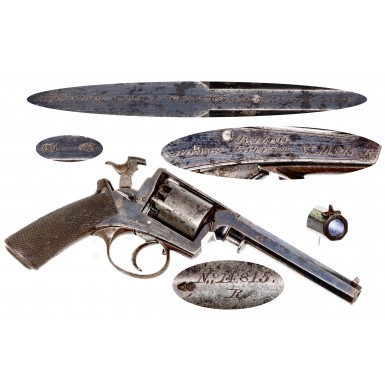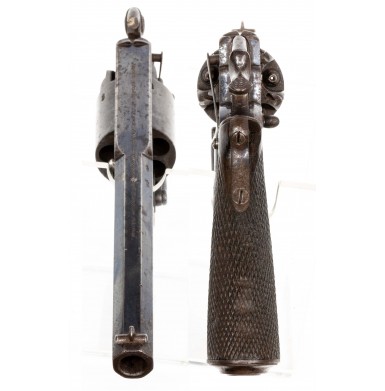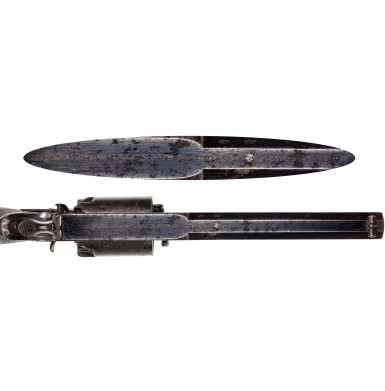Beaumont-Adams Model 1854 Revolver by Deane, Adams & Deane
- Product Code: FHG-JM120-SOLD
- Availability: Out Of Stock
-
$1.00
This is a very attractive example of the Adams-Beaumont Model 1854 double action percussion revolver. These fine quality solid frame revolvers were as important to the history and development of the revolving handgun as were the developments and designs of Sam Colt. Robert Adams received his patent for a solid frame, one-piece revolver design in 1851. The patent covered his design for a very strong revolver, where the frame and barrel were produced from a single forging. Adams additionally patented a self-cocking lockwork, which today would be referred to as “double action only”. This mechanism cocked the hammer, rotated the cylinder, and released the hammer, all as the result of a single pull of the trigger. While this allowed for rapid fire, the long, heavy trigger pull inhibited accurate firing. These designs were incorporated into Adams’ Model 1851 self-cocking revolver. In 1854 Lt. Frederick Beaumont developed an improvement for Adams’ lockwork, which produced what would be called a traditional “double action” revolver today. The new lockwork allowed the revolver to operate in the fashion of Adams’ original design, but also added the facility to cock the revolver manually and fire it with a lighter “single action” trigger pull. This refinement allowed for more accurate shooting. Interestingly the development still required the trigger to rotate and index the cylinder, unlike Colt’s design, which rotated the cylinder simultaneously with the cocking of the hammer.
In 1854 Adams also patented refinements to his original frame design by adding a sliding frame mounted safety on the right side of the frame and an improved cylinder arbor retaining mechanism as well. The resultant combination of design improvements was manufactured as the Model 1854 revolver, known to most as the Beaumont-Adams revolver. The revolvers were produced directly by Adams as part of his partnership with the London based Deane, Adams & Deane, as well under license by Birmingham makers like Joseph Brazier, Isaac Hollis & Sons. William Tranter also employed Adams solid frame in the production of his revolvers. Upon the dissolution of the Deane, Adams & Deane firm, Adams went to work for the London Armoury Company, and his revolvers were produced there as well from 1857-1858.
It is difficult to ascertain exactly how many Adams patent revolvers were imported for use during the American Civil War. At least 1,075 were purchased directly by the US government. It is known that some military outfitters like Schuyler, Hartley & Graham purchased quantities of these revolvers for private sale to officers and those volunteer groups who looked to their state and local government (rather than the US government) to purchase arms. Some of the Schuyler, Hartley & Graham guns (about 300) are reported to have been purchased by the state of Alabama prior to the war. Virginia and Georgia are reported to have made pre-war purchases of these revolvers as well. While the Confederate central government never directly contracted to purchase Adams’ patent revolvers, they concentrated on purchasing Kerr’s Patent revolvers from the London Armoury Company, Confederate speculators and individual states did purchase these fine English revolvers in some quantity. A number of Confederate identified and presented Adams’ revolvers exist in public and private collections, including #40537 in the Museum of the Confederacy. This revolver is cased with an engraved presentation plaque from Robert Adams to Confederate General Stonewall Jackson. Two other Adams revolvers in the low 41,XXX range are attributed to Confederate naval use aboard the CSS Shenandoah.
Most Confederate war time purchases are believed to have fallen within the 33,000 to 42,000 serial number range, although it is quite likely that guns produced prior to that range (and imported to America) were used, and in some cases old stock was sold to Confederate speculators, resulting in pistols that were several years old passing through the blockade. Civil War regiments that are known to have carried or been issued Adams Patent revolvers include the 8th PA and 2nd MI cavalry on the US side and the 1st & 5th VA and 5th GA cavalry on the CS side. It is generally assumed that the majority of these guns were 54-bore Beaumont Adams M-1854 pattern revolvers.
This Model 1854 Beaumont Adams Revolver is in about NEAR FINE condition. The gun is a 54 bore (.442 caliber) revolver with a 5-shot cylinder with the serial number 14815R. While it is difficult to date Adams revolvers from their serial numbers the way you can with Colt’s, it is safe to assume that this revolver was probably produced in late 1855 or early 1856. The Model 1854 frame improvements were not put into production until February of 1855, and London Armoury production started somewhere in the low 17,000 serial number range in late 1856 or early 1857. The R-suffix to the serial number indicates manufacture by Adams, and later the London Armory Company while Adams was employed there. The gun also bears the B-prefix serial number B.1500, a reference to Beaumont’s lockwork patent. This additional number was applied to Adams revolvers from mid-1855 through the expiration of the Beaumont patent royalty agreement with Adams circa 1862. The “B number” indicates that this was only the 1,500th pistol to be produced with the Beaumont patent lockwork. The topstrap and barrel is crisply engraved with the retailer mark:
DEANE, ADAMS & DEANE. 30 KING WILLIAM St LONDON BRIDGE.
The obverse frame is engraved in two lines below the cylinder:
B.1500
ADAMS’ PATENT No 14185R.
The cylinder bears the matching serial number 14185R. The cylinder has the expected London commercial proof marks between the chambers and the barrel has a pair of London proofs on the upper left angled flat. The barrel is 5 ¾” in length and is rifled with three wide grooves, roughly twice the width of the lands. The bore rates about VERY GOOD and is dark and dirty with scattered light to moderate pitting along its length. The lower front of the frame to barrel lug is marked in two lines DA&D / 54, indicating that the frame itself was produced by Deane, Adams and Deane and the gun is 54-Bore.
As previously noted, the gun is in about NEAR FINE overall condition, and retains much of its original finish. The barrel retains about 50%+ of the original bright polished blue, and the frame retains about 30%+ of its original finish. The cylinder appears to have been case hardened, not blued, and has a slightly mottled smoky brown-gray patina. The barrel and frame show a mixture of steel gray and plum brown patina in the areas where the finish is worn off. The barrel and frame are mostly smooth and essentially free of any pitting, with only some very scattered patches of lightly oxidized surface roughness, peppering, and pinpricking present. The cylinder shows light to moderate pinpricking over its entire surface, with light pitting and oxidation present in the percussion cone (nipple) recesses. All of the original cones are all present and in very good condition. The gun retains the rarely encountered Adams-style loading lever, which is marked Rigby’s / PATENT in tiny two-line cartouche on the reverse near the tip, along with the patent tracking serial number 6418. These loading levers were an improvement over the earliest Adams system which did not utilize a loading lever but were nowhere near as effective as the more often encountered Kerr’s patent rammer, which typified Adams’ revolver production at London Armoury and after the dissolution of his association with that company as well. The lever has a mottled gray patina and retains only the slightest traces of its original blued finish on the front side and about 30% bright fire blue on the reverse, where been the frame has protected it. The loading lever functions correctly and locks securely into place within the left side of the grip. The action works very well in both single and double action modes. The hammer and trigger retain some traces of their original casehardened colors and have faded to a mottled silvery color. The iron trigger guard and butt cap both retain traces of their original blue, with the balance of their metal having a smooth, untouched brown patina. The gun is a transitional M1854 model and retains both the 1851 style spring mounted hammer safety on the left side of the frame and the new M1854 patent sliding safety on the right side of the frame. Both parts function exactly as they should and are in excellent mechanical condition. The presence of the spring safety which functions as a half-cock and frees the cylinder to rotate means that there is no half-cock notch in the hammer. Eventually the frame mounted safety was eliminated, and a conventional hammer notch half-cock was adopted. The checkered one-piece walnut grip is in VERY GOOD+ condition, showing the usual expected wear, with some minor flattening to the tips of the checkering. The grip also shows some light scattered handling dings and mars. The grip is solid with no chips, cracks or repairs noted. Overall, the condition of the revolver is indicative of a gun that was carried and used quite a bit but was never abused during its service life.
Overall, this is a very nice-looking Adams patent revolver, with some scarce features and in a very nice state of preservation. These guns were as important to the development of revolvers in England and on the European continent as the Colt revolvers were in America and were some of the first truly successful double action style service revolvers. These guns saw service on both sides during the American Civil War, and a Beaumont Adams revolver is a must have in any Civil War revolver collection.
SOLD
Tags: Beaumont-Adams, Model, 1854, Revolver, by, Deane, Adams, Deane











